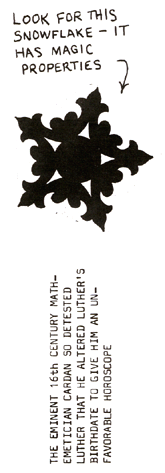|
POEE ASTROLOGICAL
SYSTEM
1. On your next birthday, return to the place of your birth and,
at precisely midnight, noting your birth time and date of
observation, count all visible stars.
2. When you have done this, write to me and I'll tell you what
to do next.
|
|
The theorem
to be proved is that if any even number of people take seats at
random around a circular table bearing place cards with their
names, it is always possible to rotate the table until at least two
people are opposite their cards. Assume the contrary. Let N be the
even number of persons, and let their names be replaced by the
integers 0 to N-1 "in such a way that the place cards are numbered
in sequence around the table. If a delegate D originally sits down
to a place card P, then the table must be rotated R steps before he
is correctly seated, where R=P-D, unless this is negative, in which
case R=P-D+N. The collection of values of D (and of P) for all
delegates is clearly the integers 0 to N-1,each taken once, but so
also is the collection of values of R, or else two delegates would
be correctly seated at the same time. Summing the above equations,
one for each delegate, gives S-S+NK, where K is an integer and
S=N(N-1)/2, the sum of the integers from 0 to N-1. It follows that
N=2K+1, an odd number." This contradicts the original
assumption.
"I actually solved this problem some years
ago," Rybicki writes, "for a different but completely equivalent
problem, a generalization of the nonattacking 'eight queens'
problem for a cylindrical chessboard where diagonal attack is
restricted to diagonals slanting in one direction only."
|
 |